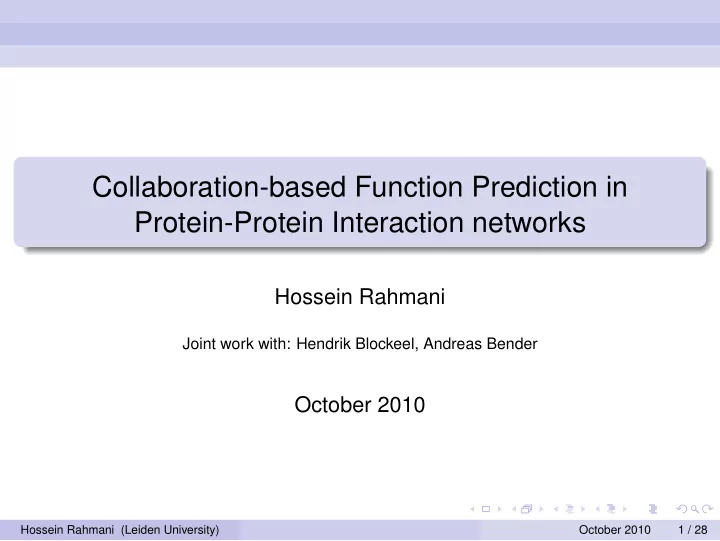

Collaboration-based Function Prediction in Protein-Protein Interaction networks Hossein Rahmani Joint work with: Hendrik Blockeel, Andreas Bender October 2010 Hossein Rahmani (Leiden University) October 2010 1 / 28
Protein-Protein Interaction (PPI) Networks Hossein Rahmani (Leiden University) October 2010 2 / 28
Function Prediction in PPI Networks Hossein Rahmani (Leiden University) October 2010 3 / 28
Outline Similarity based Function Prediction Proposed Methods: Collaboration based Function Prediction Evaluation Hossein Rahmani (Leiden University) October 2010 4 / 28
Similarity based Function Prediction Methods Similarity based Function Prediction Methods Assumption: Interacting proteins have similar functions Optimization criteria: Minimizing the number of interacting pairs of proteins with no common function Majority Rule Functional Clustering Hossein Rahmani (Leiden University) October 2010 5 / 28
Similarity based Function Prediction Methods Majority Rule Predicted function: Most common function(s) among classified partners Problem: Links unclassified-unclassified proteins completely neglected Hossein Rahmani (Leiden University) October 2010 6 / 28
Similarity based Function Prediction Methods Functional Clustering Cluster the PPI network Predict the function of unclassified protein based on the cluster they belong to Hossein Rahmani (Leiden University) October 2010 7 / 28
Similarity based Function Prediction Methods Outline Similarity based Function Prediction Proposed Methods: Collaboration based Function Prediction Evaluation Hossein Rahmani (Leiden University) October 2010 8 / 28
Collaboration based Function Prediction Method Collaboration based Function Prediction Method Main Idea: A biological process is the aggregation of each individual protein’s functions Assumption: Topologically close proteins tend to have collaborative functions Collaborative functions: Pairs of functions that frequently interface with each other in different interacting proteins A Reinforcement Based Function Predictor (RL) SOM Based Function Predictor protein p : � Function Set : FS p ; FS p ( f i ) Neighborhood Function Vector : NB p ; NB p ( f j ) Hossein Rahmani (Leiden University) October 2010 9 / 28
Collaboration based Function Prediction Method A Reinforcement Based Function Predictor Hossein Rahmani (Leiden University) October 2010 10 / 28
Collaboration based Function Prediction Method A Reinforcement Based Function Predictor Prediction Time: Select candidate functions Rank candidate functions based on how well they collaborate with the neighborhood of unclassified protein p Formula (1) assigns a collaboration score to each candidate function f c : � Score ( f c )= NB p ( f j ) ∗ FuncColVal ( f j , f c ) (1) ∀ f j ∈ F Hossein Rahmani (Leiden University) October 2010 11 / 28
Collaboration based Function Prediction Method SOM Based Function Predictor Self Organizing Map (SOM) | inputNeurons | = | outputNeurons | = | F | inputNeuron ( i ) = NB p ( f i ) outputNeuron ( i ) = FS p ( f i ) Tune Parameters Predict Functions Hossein Rahmani (Leiden University) October 2010 12 / 28
Collaboration based Function Prediction Method Outline Similarity based Function Prediction Proposed Methods: Collaboration based Function Prediction Evaluation Data sets Parameter Tuning Similarity V.S Collaboration Hossein Rahmani (Leiden University) October 2010 13 / 28
Evaluation Datasets Datasets Three Yeast Datasets: Krogan, VonMering and DIP-Core Number of Proteins Number of Interactions Von Mering 2401 22000 Krogan 2708 14246 DIP-Core 2388 4400 Table: Statistical information of datasets. Hossein Rahmani (Leiden University) October 2010 14 / 28
Evaluation Parameter Tuning Parameter Tuning SOM method Candidate Function Strategy Decreasing Learning Rate Termination Criteria Majority Rule Wider Neighborhood Level Hossein Rahmani (Leiden University) October 2010 15 / 28
Evaluation Parameter Tuning “Candidate Function Strategy” in SOM method Second function level produces the best result Hossein Rahmani (Leiden University) October 2010 16 / 28
Evaluation Parameter Tuning “Decreasing Learning Rate” in SOM method Fmeasure values maximize when DecLR equals to 0.9 Hossein Rahmani (Leiden University) October 2010 17 / 28
Evaluation Parameter Tuning “Termination Criteria” in SOM method TC = 10 produces the best result Hossein Rahmani (Leiden University) October 2010 18 / 28
Evaluation Parameter Tuning “Wider Neighborhood Level” in Majority Rule method NB-Li represents the 1-, 2- or 3-neighborhood of the protein Mostly, no improvement by considering wider neighborhood Hossein Rahmani (Leiden University) October 2010 19 / 28
Evaluation Similarity Vs Collaboration Similarity V.S Collaboration Compare Collaboration based methods (SOM and RL) with Similarity based methods (MR and FC) Five different function levels 11.02.01 (rRNA synthesis) Vs 11.02.03 (mRNA synthesis) Hossein Rahmani (Leiden University) October 2010 20 / 28
Evaluation Similarity Vs Collaboration Similarity V.S Collaboration Hossein Rahmani (Leiden University) October 2010 21 / 28
Evaluation Similarity Vs Collaboration Similarity V.S Collaboration Hossein Rahmani (Leiden University) October 2010 22 / 28
Evaluation Similarity Vs Collaboration Similarity V.s Collaboration Hossein Rahmani (Leiden University) October 2010 23 / 28
Evaluation Similarity Vs Collaboration Similarity V.s Collaboration In all three datasets, collaboration methods predicts functions more accurately than similarity based methods More detailed functions level → More difference in performance Hossein Rahmani (Leiden University) October 2010 24 / 28
Conclusions Conclusions Function prediction in PPI networks Similarity based Approaches Collaboration based Approaches Reward-Punish (RL) Self Organizing Map (SOM) Similarity V.s Collaboration 3% to 17% improvement in F-measure values Hossein Rahmani (Leiden University) October 2010 25 / 28
Thanks! Hossein Rahmani (Leiden University) October 2010 26 / 28
Reinforcement based Function Predictor Reinforcement based Function Predictor ∀ f i ∈ FS p : FuncColVal ( f i , f j )+= NB p ( f j ) ∗ R support ( f j ) ∀ f i ∈ FS p : P FuncColVal ( f i , f j ) − = support ( f j ) Candidate Function Strategies: First Function Level Strategy Second/Third/Fourth Function Level Strategy Hossein Rahmani (Leiden University) October 2010 27 / 28
SOM based Function Predictor SOM based Function Predictor Hossein Rahmani (Leiden University) October 2010 28 / 28
Recommend
More recommend